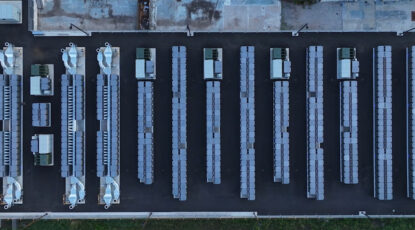Without efforts to reduce emissions, our planet is on track to a 2.7-degree Celsius temperature increase, significantly above the 1.5-degree threshold. Coal, natural gas, and oil industries are some of the primary contributors to carbon emissions. While producing electricity to power our homes and offices, carbon (alongside other harmful gases) is released into the air as byproducts. Carbon traps existing heat in the air, so an increase in carbon leads to a rise in global temperatures.
What contributes to global warming gases?
- Generating electricity
- Fueling vehicles
- Heating and cooling buildings
- Producing food and goods
For greenhouse gases and to meet decarbonization goals, emissions must be cut by a staggering 45% within the next 8 years. While electricity production is unavoidable and necessary, there are many ways to produce cleaner electricity. Rather than a binary of net zero, which could take decades to achieve, a shift from high to low carbon-intensity production methods is just as valuable.
What is Decarbonization?
In the face of escalating climate change, deep decarbonization has emerged as a critical strategy for ensuring a sustainable future. But what is decarbonization, and why is it so crucial?
“Deep decarbonization refers to removing the amount of global warming gases emitted to the atmosphere throughout our economic activity.” – Stephen Lamm, Sr. Director of Sustainability
It is not only minor adjustments or incremental changes; deep decarbonization calls for a transformation of how energy is produced and consumed.
Why Does Deep Decarbonization Matter?
- Climate Stability: Global warming significantly influences extreme weather patterns, and reducing carbon emissions through decarbonization is imperative for stabilizing the climate.
- Public Health: Reducing fossil fuel combustion directly addresses the public health crisis.
- Clean Energy & Electricity: Increasing renewable energy can reduce reliance on fossil fuel markets and greenhouse gas emissions.
What is the Role of Clean Electricity in Decarbonization?
As the economy moves towards a more electrified infrastructure, we are in a situation of increasing demand for energy but not enough clean energy supply. The rapid demand creates an issue of creating a challenge for sustainable power. Clean energy plays a vital role in lowering carbon emission efforts because it can power several aspects of the economy. Through cleaner decarbonization technology usage like electrolyzers, carbon capture, or hydrogen gas, the shift from heavy reliance on fossil fuels will significantly decrease carbon emissions.
How Decarbonization Technology and Strategies Reduce Carbon Emissions
Carbon capture utilization and sequestration (CCUS) separate CO2 from other gases emitted from a facility and capture it before entering the atmosphere. It is then permanently sequestered underground or utilized for various products such as concrete. This process is a significant part of reducing global warming and climate change.
Electrolyzers are devices that use electricity to split water and other components through electrolysis. It is mostly used to produce hydrogen gas—a critical alternative to decarbonizing the energy economy.
Renewable energy transition shifts away from fossil fuels and towards low-emission energy carriers such as hydrogen, which will help build a cleaner economy. Strategic planning, stakeholder engagement, and policy alignment are three key governance approaches that are vital to accelerating the shift to clean energy.

Real-World Examples of Successful Decarbonization Goals:
Sweden has been an environmental pioneer since 1967, the first country to pass an environmental protection act. Since then, Sweden has not looked back and managed to grow a sustainable economy while reducing carbon emissions and having 60% of their national energy supply come from renewables.
- Goals:
- 2030: Transport sector be fossil-free.
- 2045: Carbon neutrality and 100% renewable energy.
- Achieved:
- Since 2022, more than 60% of Sweden’s electricity has come from renewable sources, and by 2023, Sweden ranked second in the Global Innovation Index.
- Implemented sustainable policies with their carbon tax, introduced in 1991, providing a strong economic incentive for reducing emissions
Why Collaboration is Key: Working with Decarbonization Partners
- Policy Influence
- Industry alliances need to collaborate with governments to establish a partnership in shaping policies to hasten decarbonization. The exchange of knowledge will ensure that implemented regulations accurately address decarbonization goals.
- Supply Chain Decarbonization
- Influences across all sectors must collaborate to increase market demand for low-carbon solutions across the industrial value chain. This is important to push businesses to implement low-carbon performance into traditional criteria checklists such as cost, safety, durability, and resilience.
Achieving Decarbonization Goals
The Paris Agreement spearheads initiatives to decarbonize the planet with over 98% of greenhouse gas emitters onboard. This is promised to work towards staying under the 1.5 degrees Celsius threshold and are bound by this treaty. To date, many companies have established low-carbon and even zero-carbon solutions. By 2030, sectors contributing to 70% of global emissions could have numerous zero-carbon solutions.
Within the next decade, much of our economy will be electrified as countries take on a more sustainable perspective. One of today’s biggest challenges is bringing clean energy sources online in a short period of time.
Current predictions for the future of decarbonization are headed towards more aggressive policy action to incentivize infrastructure build-out, increased use of hydrogen fuel cells, decarbonization technology, and clean energy sources.
Bloom’s fuel cell technology extracts and recycles hydrogen and water from fuel cell exhaust while separating water vapor and CO2 emissions. The captured CO2 can be stored or repurposed for new applications. Our Bloom Energy Servers operate on hydrogen, biogas, or natural gas to generate decarbonization goals or clean electricity.
Bloom provides companies access to the most efficient system for current fuel sources, with adaptable technology equipped for advanced decarbonization with zero-carbon hydrogen.
Decarbonization FAQs
Q1 – What is Decarbonization?
Decarbonization is the term used for the removal or reduction of carbon dioxide (CO2) output into the atmosphere. This process is achieved by switching to the usage of low-carbon energy sources.
Q2 –Why is Decarbonization important?
Decarbonization is crucial for mitigating the consequences of climate change, including rising sea levels and extreme weather events. Decreasing the amount of greenhouse gas emissions in the atmosphere will benefit human health and is a leading step towards a sustainable future.



